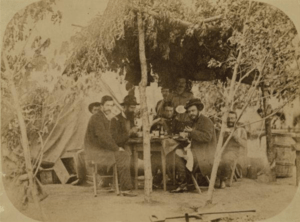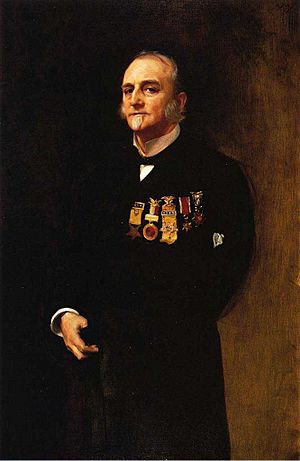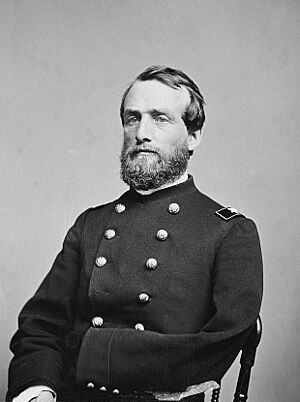Lucius Fairchild facts for kids
Quick facts for kids
Lucius Fairchild
|
|
|---|---|

Fairchild c.1866
|
|
| 23rd United States Minister to Spain | |
| In office January 26, 1880 – December 20, 1881 |
|
| President | |
| Preceded by | James Russell Lowell |
| Succeeded by | Hannibal Hamlin |
| 10th Governor of Wisconsin | |
| In office January 1, 1866 – January 1, 1872 |
|
| Lieutenant | Wyman Spooner Thaddeus C. Pound |
| Preceded by | James T. Lewis |
| Succeeded by | Cadwallader C. Washburn |
| 8th Secretary of State of Wisconsin | |
| In office January 4, 1864 – January 1, 1866 |
|
| Governor | James T. Lewis |
| Preceded by | James T. Lewis |
| Succeeded by | Thomas S. Allen |
| Personal details | |
| Born | December 27, 1831 Franklin Mills, Ohio |
| Died | May 23, 1896 (aged 64) Madison, Wisconsin |
| Resting place | Forest Hill Cemetery Madison, Wisconsin |
| Political party | Democratic (pre war) Republican (post war) |
| Spouse | Frances Bull Fairchild |
| Children | 5 |
| Parents |
|
| Relatives | Cassius Fairchild (brother) |
| Profession | Clerk, Politician, Soldier |
| Signature | |
| Military service | |
| Allegiance | |
| Branch/service | Union Army |
| Years of service | 1858–1863 |
| Rank | |
| Unit | Iron Brigade Army of the Potomac |
| Commands | 2nd Reg. Wis. Vol. Infantry |
| Battles/wars | American Civil War
|
Lucius Fairchild (born December 27, 1831 – died May 23, 1896) was an important American leader. He was a politician, a general in the Union Army during the American Civil War, and a diplomat. He served as the tenth Governor of Wisconsin. He also represented the United States as a special envoy to Spain.
Contents
Lucius Fairchild's Military Career
Lucius Fairchild started his military journey in 1858. He joined a volunteer group in Wisconsin called the "governor's guard." By 1861, this group became Company K, 1st Wisconsin volunteers.
Fighting in the Civil War
Fairchild's company fought in the American Civil War at Falling Waters. They faced the "Stonewall Brigade" led by General Thomas J. Jackson. In August 1861, Fairchild became a captain and a major in the 2nd Wisconsin Infantry Regiment.
The 2nd Wisconsin Regiment was part of General William T. Sherman's brigade. After a big army change, Fairchild chose to stay with the 2nd Wisconsin. He was soon made a lieutenant colonel.
Joining the Iron Brigade
His regiment then joined the famous Iron Brigade within the Army of the Potomac. They fought in the Second Battle of Bull Run. On September 8, 1862, Fairchild was promoted to colonel of the 2nd Wisconsin Infantry.

By February 1863, the Iron Brigade was renamed. Fairchild became the highest-ranking officer in his army corps. This was a big honor for him.
Battle of Gettysburg and Injury
Fairchild and the 2nd Wisconsin Infantry showed great bravery at the Battle of Antietam. They also stood out on the first day of the Battle of Gettysburg on July 1, 1863. They were the first infantry regiment to meet the Confederate Army up close.
During this battle, Fairchild's regiment captured the first Confederate general officer of the war, Brig. Gen. James J. Archer. Soon after, his regiment was attacked from the side. They lost many soldiers and officers. Fairchild was shot in his upper arm. He was captured, treated, and then released. While he was recovering, his left arm had to be removed. President Abraham Lincoln then made him a brigadier general on October 19, 1863.
Lucius Fairchild's Political and Diplomatic Career
Fairchild left the military in November 1863. He then started his career in politics.
Serving Wisconsin as Governor
He was first appointed Secretary of State of Wisconsin from 1864 to 1866. After that, he was elected Governor of Wisconsin for three terms. He served as governor from 1866 to 1872.
Representing the United States Abroad
After being governor, Fairchild became a U.S. consul in Liverpool in 1871. Then he was made consul general in Paris from 1880 to 1881. Finally, he became the Envoy Extraordinary and Minister Plenipotentiary to Spain. This meant he was the top U.S. representative in Spain.
Later Leadership Roles
Fairchild also led two important groups for Civil War veterans. He was Commander-in-Chief of the Grand Army of the Republic (1886–1887). He also led the Military Order of the Loyal Legion of the United States (1893–1895). He was a strong supporter of civil rights for African Americans. He believed that the Reconstruction period after the war ended too soon.
Lucius Fairchild's Family Background

Lucius Fairchild's family came from England. His ancestors moved to New England in the 1600s. Later, they moved to upstate New York after the American Revolution. Then, they moved to northern Ohio. Fairchild had a grandfather and a great-grandfather who fought in the American Revolution.
His parents were Sally (Blair) and Jairus C. Fairchild. His father was the first State Treasurer of Wisconsin and the first Mayor of Madison, Wisconsin. Lucius had two brothers who also served in the Civil War. His brother Cassius Fairchild was a colonel in the Union Army. His brother Charles served in the Union Navy. Lucius Fairchild was married to Frances Bull Fairchild. They had three daughters: Mary, Sarah, and Caryl.
Lucius Fairchild's Legacy
Several places and things were named in honor of Lucius Fairchild. The town of Fairchild, Wisconsin is named after him. A Liberty ship built in 1943 was named SS Lucius Fairchild. Mount Fairchild in Rocky Mountain National Park, Colorado, is also named for him. In Kent, Ohio, where he was born, Fairchild Avenue carries his name. A famous portrait of General Fairchild by John Singer Sargent is in the Wisconsin Historical Museum.
Images for kids



